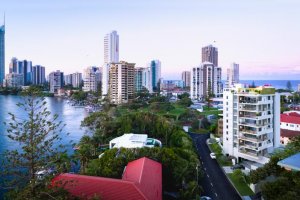South-East Queensland Positive Property Options

In the third quarter of 2017 demand rose 2.7% which is a fabulous indicator and a positive result and is the culmination of five consecutive quarters of positive growth.
Access Economics have forecast Queensland demand for property will average 3.8% annual growth over the next four years, easily outstripping the average annual growth of 0.2% over the last five years.
The infrastructure boom is set to takeover apartment construction according to JLL, Queensland employment surged 4.1% year-on-year to August 2017, easily surpassing Victoria and New South Wales at 3.7% and 2.3% respectively, and the national figure of 2.8%.
This is in spite of a clear slowdown in the construction of apartments in Brisbane that has been well underway for the better part of 18 months.
Building approvals for units in the greater Brisbane area were down 59.9% for the year to August 2017 as it became harder for both developers and investors to obtain finance.
Queensland’s net interstate migration has been steadily increasing since 2014 and history suggests that the dwelling price difference to Sydney (and Melbourne) should lead to a surge in interstate migration in the coming years and a subsequent surge in dwelling values in Brisbane.
According to the Macquarie Bank equity strategy team we can expect "another great wave of interstate migration into Queensland."
Based on past patterns, approximately 130,000 people could be expected to make the migration north into Queensland over the next three years.
The average number of migrants over a three-year period is greater than the peak year in the above chart.
Migration on this scale would more than likely soak up any additional supply in the Brisbane apartment market, and could also drive up real estate prices.
The Gold Coast will see improving employment and net migration and will boost in growth is likely to see the same benefits and strong results.
Where the Gold Coast market differs is on the supply side of the equation particularly since the global financial crisis.
Lenders exposed to the Gold Coast apartment market experienced losses at this time, and as a result lending on large developments all but dried up in the ensuing years.
Under normal circumstances, a chronic lack of supply would lead to a sharp upturn in prices but in the case of the Gold Coast, there was an equal lack of confidence from buyers, particularly from interstate investors.
So, for the Gold Coast, prices are only really now getting back to pre-GFC levels for off-the-plan apartments in desirable beachside locations.
The median apartment price for Gold Coast has practically flat-lined since around 2008.
Historically, the median apartment price of Gold Coast and Sydney have converged after Sydney has had a run up in prices. This should give confidence to buyers of Gold Coast apartments in the short to medium term, given the gap is at the widest it has been in the last 20 years.
South-east Queensland’s property market seems to have weathered the worst of the economic storm and the oversupply of apartments and economic and demographic signs are now positive for the Gold Coast:
Extremely strong outlook for the state economy (projections for State Final Demand) huge pipeline of infrastructure yet to be complete
If the latter plays out as expected, this should provide an enormous transfer of wealth from the southern states and would have far reaching positive outcomes for the economy and property prices as a whole.
If the market can navigate 2018 safely, the ensuing years could potentially experience some of the strongest years of price growth for south-east Queensland property since the early 2000s.
